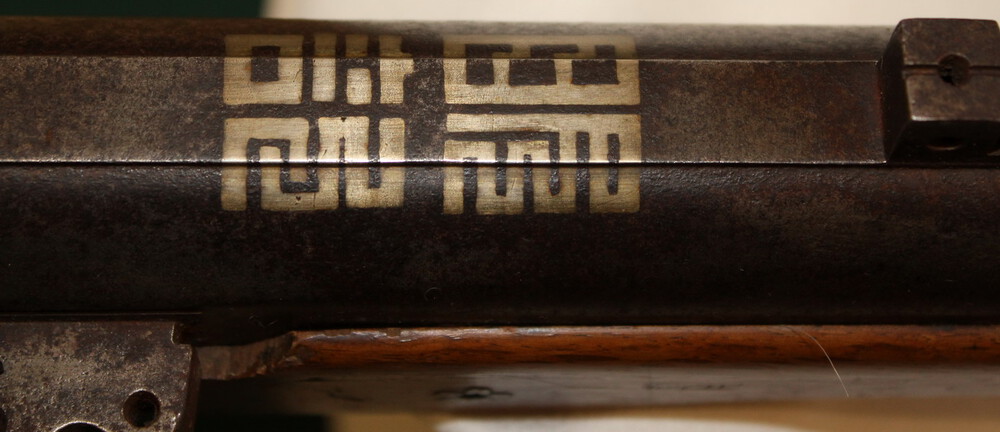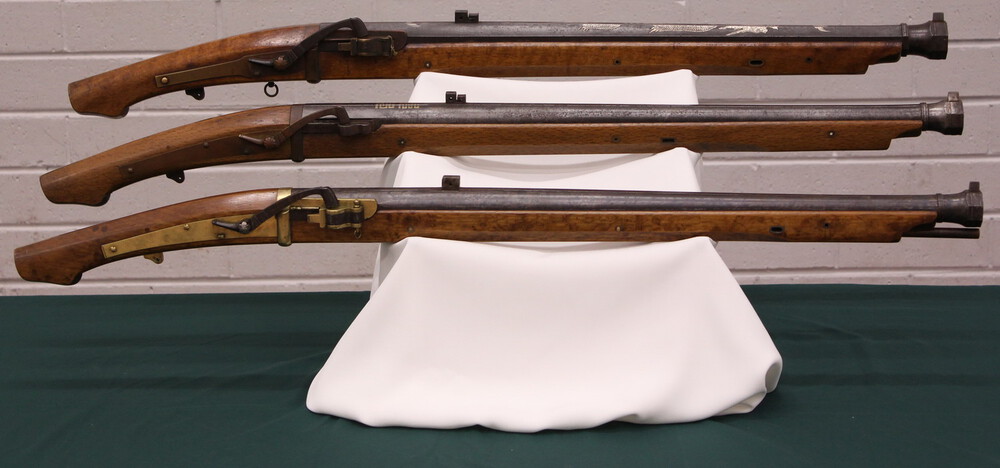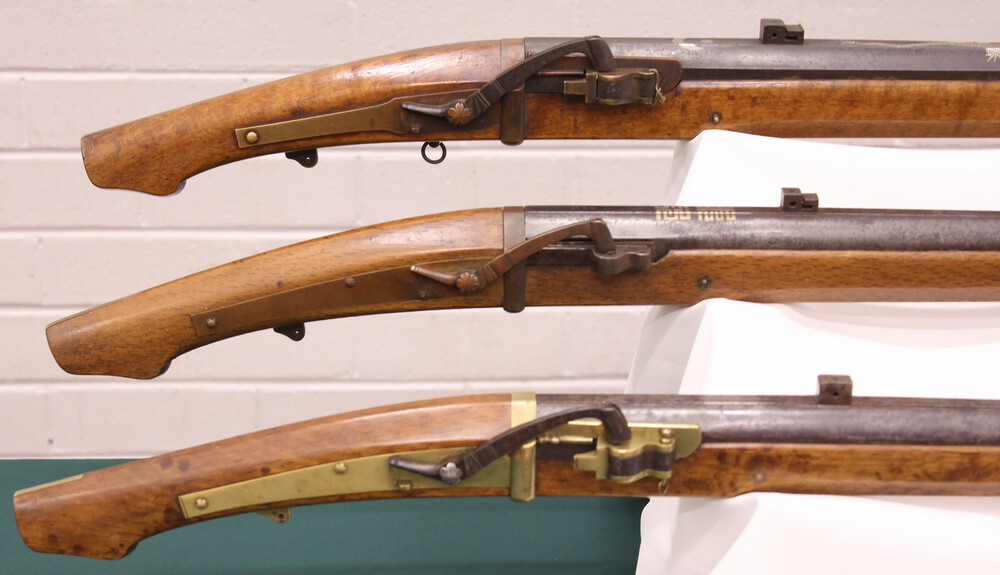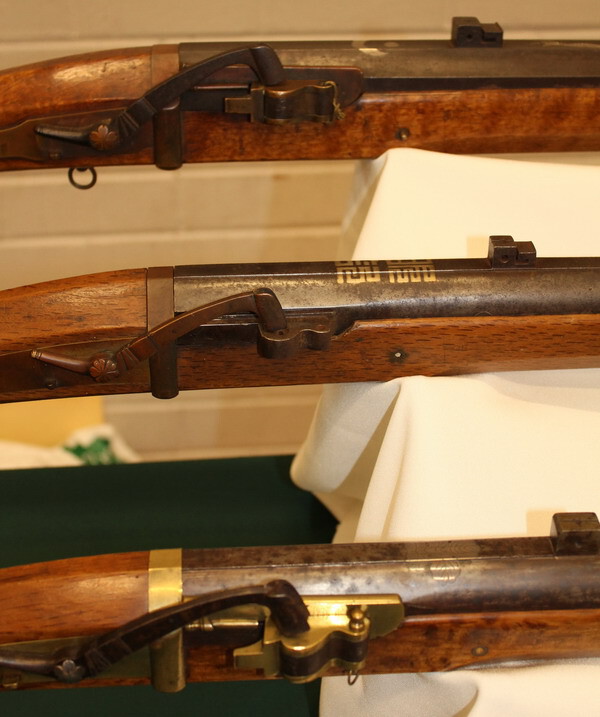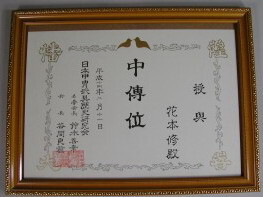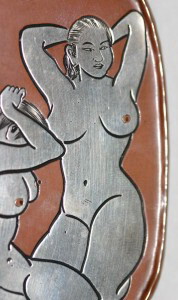-
Posts
2,745 -
Joined
-
Last visited
-
Days Won
27
Everything posted by Bazza
-
I believe this is not a signature, but a representation of wood grain or something else. I once saw a beautiful imitation of mokume-style wood grain on a Naotane wakizashi. Regards, BaZZa.
-
Removable rims are briefly discussed in this NMB thread: http://www.militaria.co.za/nmb/viewtopi ... 831#p14831 Regards, BaZZa.
-
I've seen a number of fuchi modified in this way. The skill required to make and fit a close-fitting sleeve to carry a "rim" around the fuchi is considerable. I conclude from those I've seen that if the only purpose of this exercise is to put a decorative rim on, then the reason for it has to come down to "a style". It also suggests that the rim is a much later addition??? I've attached a single image got from the web some 6 years ago. I have other images I'll post if I can find them. Regards, BaZZa.
-
The trouble with hammering on silver foil, even gently with wood, is that the silver foil will most likely be damaged - a great pity if it has nice work on it. A method I have used very successfully without damage is to slowly pour a kettle of boiling water over the habaki (tang down) whilst rotating the blade. When the water is all gone take a piece of thick cloth (have it ready to hand), wrap it around the habaki, grip it tightly on the habaki, and gently (more or less...) bang the tang down on a largish block of soft wood (eg., pine in a 4 inch x 4 inch x 12 inch length). The habaki usually comes off fairly easily. If this doesn't move the habaki then one is reduced to hammering directly on it. Again, here one can still use the hot water, but use a piece of soft wood as a drift (i.e., intermediary block between the hammer and habaki). Regards, BaZZa. (aka Barry Thomas)
-
Tom, yes??? I thought you were kidding, so I put [ rabbit izumo ] into google and got a surprise. Here is an interesting blog: http://fulbrightika.blogspot.com.au/201 ... tures.html with lots of good info about Izumo, but here is the salient paragraph: ---------------------------------------------- Ookuninushi-no-mikoto (who, by the way, has about a bazillion names) had eighty brothers,* and all his brothers decided to go to woo an extremely beautiful women. They made Ookuninushi-no-mikoto carry their bags, because they were great brothers. Anyway, as they were walking along, they came across a rabbit with no fur. They told the rabbit that it should go bathe in salt water and then lie on top of a mountain and let the wind blow on it. Needless to say, the rabbit found this experience incredibly painful, and by the time Ookuninushi-no-mikoto showed up, it was crying in pain. It turned out that the reason the rabbit had no fur was because it had deceived a crocodile** into forming a bridge from another island to the mainland, by telling him that they should have a contest to see who had more relatives (and the rabbit would count the crocodile's relatives by hopping across the tops of their heads to the mainland). The crocodile realized the deception right before the rabbit made it to land and skinned the rabbit. Anyway, Ookuninushi-no-mikoto told the rabbit to wash in the river and then roll in a special kind of pollen. When the rabbit did this, its skin and fur was healed. The rabbit thanked Ookuninushi-no-mikoto and told him that he would be the one to gain the incredibly beautiful woman all his brothers were going to woo. When Ookuninushi-no-mikoto showed up with his brother's bags, the incredibly beautiful woman (who may or may not have been a princess) said, "Actually I am going to marry Ookuninushi-no-mikoto," which, needless to say, ticked off his brothers and they killed him twice, but that's another story entirely. ---------------------------------------------- So I look to have been right when I called the animal on my long ago tsuba "a well-endowed rabbit"!!! Bestests, BaZZa.
-
Morita san, Thank you for that tasty tidbit about the middle gun mon and possible maker. I'm about to retire for the night and will endevour to dismantle the guns tomorrow and photograph the inside mei. Please bear with me as this may take a few days due to unexpected commitments (you wouldn't believe...). Oyasumi nasai... BaZZa.
-
On rice glue - from Bazza's archive, courtesy David McDonald's experience freely passed on in July 2000 via Chris Bowen's still-running discussion list... Bestests, BaZZa. ------------------------------------------------------------------------- xxx wrote: > Hello all! > I need some advice on restoring a military mounting (nothing special AND of no artistic value!!) > Do you have any ideas how to glue some lengthwise cracks in a gunto tsuka WITHOUT removing the ito and same? Binding is very tight and original wrap, so I like to keep the antique look. > But the wood core has some lengthwise cracks and the splittet handle *moves* under binding and same if squeesed like a towel > I do not want to do the re-glueing for swinging the sword (that might be to dangerous) but to keep the mounting from falling apart. > Regards > Andreas From: David W. McDonald To: Subject: Re: How to glue a tsuka Date: Monday, July 10, 2000 1:30 PM Dear Andreas Here are two thoughts. 1. If the tsuka is very loose then you might be able to: a. If shingunto tsuka and the ito does not go through the kashira try removing the wood core, after removing the screwed in "holes" that hold the sarute, leaving ito on the same. b. If this works then use a wood glue and carefully glue up all cracks. Do not glue the two halves together. Wrap with a small cord and and let dry over night. Do not tie to tight. c. Now make some rice glue. Use cooked rice and take about 5 grams (0.5 teaspoon) and mush between two pieces of wood. I use a wooden spoon and a piece of wood that has been dished out to match the spoon. Add a little water until you have a liquid paste about like the viscosity and thickness about like warm honey. d. Use this glue to add small amount on one of the wood core pieces (one of the halves). Use your finger to wipe off glue on the inside edge of the wood core (next to the area were the wood was inletted for the nakago). e. Use the small cord to wrap the the two halves of wood core together. You might want to slide onto the nakago to make sure that it will fit. Remove from nakago and let dry over night. f. If all has gone well side wood core into same to see if it still fits. If it works then remove and slightly wet the wood core and spread a thin coat of rice glue onto wood core and then slight back into same. Add the screwed in "hole" for the sarute. g. Place onto nakago. It maybe tight and you might need to lightly tap into place with a plastic hammer. 2. If the wood core does not slide out of same or same is in two halves not a full wrap then: a. Use a thin screw driver to force open one of the cracks. Use a long thin metal spatula add wood glue. Do this for all cracks. b. Slide tsuka onto nakago until it is snug but not tight. Let set for about 5 min and then carefully remove tsuka from nakago. Let dry over night. You might want to only to one crack per day. Safer. c. clean glue off nakago. d. use thin screw driver to open up one side of the two halves of the wood core. Use rice glue (see above) and add glue as far back as you can. e. Repeat with other side of wood core. f. Slide tsuka onto nakago until it is snug but not tight. Let set for about 5 min. Then remove tsuka from sword and let dry over night. g. clean nakago Cross your fingers and see if tsuka still fits your blade. Not sure if the above is clear but if not please email me with questions. This will works some times and some times it does not. Good luck david -- David McDonald Collector of Japanese Swords and Old Iron PO Box 265 WEB page - http://www.mcn.net/~jswords email - xxx@mcn.net I do tsukamaki (wrapping of sword hilts)
-
Some 30 or more years ago I had a small copper tsuba with some kind of animal on it. The animal was identical to the one on these tsuba. I had no idea what it was, or indeed how old the tsuba was. I sent a photograph of it to Bob Haynes with my description of the animal as "an over-endowed rabbit"!! Bob replied that it was a fox. And so all these years later I see the animal again. Bob's letter and photographs of the tsuba (I sold or traded it off long ago) are deeply buried in my archive and not presently available, but I'll surely remember this thread whenever I find them again. I seem to recall Bob saying he thought my tsuba was ca1400. Again, I note that my tsuba was round with a rim and so quite different from those presented here, but I have no doubt the fox was EXACTLY the same. Regards, BaZZa.
-
-
Ahh, thanks for that Piers. Now. I've got some photos and I'm going to puddle around trying to attach them. These are just the display shots with self-explanatory titles. I'll try and do the bbl and stock etc inscriptions later. Regards, BaZZa.
-
Jan, All, I've enjoyed this thread immensely. I note your teppo has a hole in the stock for the fire-cord to go through. I have only ever seen 'in my hands' one teppo with this feature and I think it is somewhat rare. Unfortunately it went to someone with more financial clout than I can muster. You mention Noda Zenshiro Kiyotaka as a gunmaker - this is none other than the famous swordsmith HANKEI - see here for a summary of his career http://www.touken.or.jp/english/translation/639.htm I'm reminded that I have three teppo I've been "gunner" present here. Two of these have the NIJU MAKIWARE ('two-wrap') inscription. I'm displaying these guns at our local antique arms meeting tomorrow night, so I'll take at least a picture of the three on stands. Bestests, BaZZa.
-
I have just come from a visit to a collecting friend and had a look through the following publication: ------------------------------------------------ YANONE - THE Japanese ARROWHEAD Compiled by John EW Pflueger 1982. ------------------------------------------------ Privately published in 5 volumes it runs to about 1,000 pages on yanone types, smith names etc etc. Does anyone know of other copies??? Regards, BaZZa.
-
Yes, FUJIWARA YOSHISADA. Possibly late Koto Bungo Takada??? Regards, BaZZa.
-
Ron, Your third and bottom yanone is not an armour piercing point - they are actually "blunter", not so pointed. Having said that I don't know what yours is, but a friend of mine would. I have a friend of decades here who has been collecting yanone for - mmm - 30 years?? He has corresponded with the late Dr Grayson and others around the world. Currently another friend has scanned in our friend's recent drawings of his own and other yanone types on 53 A3 pages. His own collection runs to about 50 points most of which he has polished himself to bring them back to life from rusted remnants. He is acutely aware of the demands of polishing and a visiting polisher from Japan nearly 20 years ago remarked that the man who polished these yanone could polish swords (at the time I had a few of my friend's polished arrowheads for viewing and appreciation). He is very demanding of himself and only turned to polishing his points when he couldn't interest a polisher in Japan to take them on. He did, however, have one yanone polished in Japan - a miniature jumomji yari, very, very nice. My friend is regrettably not computer connected, but is very keen to correspond with like-minded collectors. Anyone who is interested in contact could PM me or email me directly at warlord@iinet.net.au. Regards, BaZZa.
-
3. Now for some exchanges about the tsuba on the discussion list from June 2005. I have presented only the most illuminating contributions: -------------------------------------------- COMMENT #1 No swordsman would wear this on his sword, not to a sword fight anyway. This is something you tuck in your pocket for a “buddies” meeting. The work is similar in style to other images with the theme of women bathing or women pearl divers. Ito Shinzui was a Nihonga painter famous for his Bijinga (Beautiful women) series. If I understand the description then this might be the work of someone related to a Meiji tsubako who signed Setsukoku. The outside of the box says "Sumida-gawa no zu" or image of the Sumida river... -------------------------------------------- COMMENT #2 Ito Shinsui (1898-1972) is a well known shin-hanga (modern woodblock print) artist. Artelino gives the following short biography: Shinsui Ito learned the art of printmaking at a printing company in Tokyo from the early age of twelve. Later he studied under Kiyokata Kaburagi. He was approached by the publisher Watanabe through the mediation of his teacher Kiyokata Kaburagi and made the first bijin print in 1916. It was the beginning of a life-long cooperation between Watanabe and Shinsui Ito. The artist became one of the most appreciated Shin Hanga printmakers for bijin (beautiful women) and landscapes subjects. After World War II his contribution to the development of Japanese culture was honoured by declaring him an intangible national property and by other awards. As the seller suggests, this tsuba was probably made by someone in collaboration with Shinsui, and not by Ito Shinsui himself. It is undoubtedly a modern (i.e. 20th century) piece (i.e. not only not Edo period, but not Meiji period either), possibly done by someone undertaking formal training in the fine arts as a course or term project. -------------------------------------------- COMMENT #3 This tsuba has got to be post-WWII vintage, made for the benefit of occupying red haired orangutans, but, hey, money spends. It looks like decent metalwork, though almost entirely devoid of art. Exactly what a starving post-WWII metalworker would make for a GI with lotsa bucks (yen) to spend, a Japanese metalworker without much comprehension of the historic western aesthetic appreciation of the female form. Kinda like the early Western drawings of rhinoceros made on verbal description. Essentially, it is the tsuba equivalent of the bigtits chrome female form often seen on the rear mud flaps of big rig trucks. It is regrettable that in order to eat, real craft gets dragged down to such low levels of "art". Sigh. -------------------------------------------- The final scene in this tale is the following notice on ebay: Current bid: US $1,125.00 (Reserve not met) Ended: Jun-21-05 21:00:00 PDT Start time: Jun-14-05 21:00:00 PDT History: 32 bids (US $100.00 starting bid) High bidder: User ID kept private Item location: onomichi hirosihima, Japan --------------------------------------------------- I hope this has been of interest to the Listeros. I'll work up the kozuka I mentioned and post it later, allowing some time for any discussion about the above tsuba. Best regards, BaZZa. (aka Barry Thomas)
-
And a few more pictures continued from the above, with the discussion list comments in the next post:
-
All, sorry for the delay – I’ve had house guests for a few days attending an antique arms auction in this part of the world, and I’ve had an attack or two of ‘empty bottle’ along the way… The tsuba presented here was offered for private auction sale on ebay in June 2005 by someone in Onomichi city, Hiroshima prefecture, Japan. First I’ll present the text of the sales pitch, then selected pictures, then finally the exchanges that ensued on the discussion list . 1. The sales pitch with original spelling: -------------------------------------------- This is Tsuba. There is a signature. A signature is ITOU SHINSUI GAI SESSYUKOUKU. With a paulownia box what KANZAN juged this Tsuba. A time is not known in detail, but I think this Tsuba's ages seems 100 years ago. It is constructed of gold inlay and silver inlay to copper. This Tsuba made of cooperation of ITOU SHINSUI of famous painter at the Meiji Era. I think this Tsuba's condition is good. Since all portions and photographs are taken, please have a look slowly. Since it is an old thing, please see goods well and offer a bid. Size: Length about 3.5"(9.0cm) Width about 3.3"(8.5cm) with a box Weight about 370g -------------------------------------------- 2. First six of the selected pictures - continued in the next post. These were very low resolution images originally, unfortunately, but sufficient to show “what is what”.
-
Curran - some of what I'll reveal is a tip from Milt in 2003!! Happily I have the book referred to and can post scans. Ian - the wakizashi must have been a sight!! In 2003 a correspondent wrote: ------------------------------------------------------------------ I have a catalog with a giant penis theme set of fittings.........tsuba, kozuka, menuki etc.... pretty weird. Edo period. ------------------------------------------------------------------ I sincerely hope these fittings weren't ratted from from the wakizashi in question. In response to the correspondent, Jim Gilbert wrote: ------------------------------------------------------------------ Any shunga fitting would be rather unusual, but I'd think that a shunga theme tsuba would be a bit too obvious to wear. I have to wonder whether even the few extant fittings were made for foreign sale rather than use. ------------------------------------------------------------------ Again, as promised, I'll be back... Regards, BaZZa.
-
Brian, I've found the picture, but there is a surprising context. I've found some other pics as well of shunga tosogu and discussions from a few years ago from discussion list emails. There is a tsuba with hakogaki by Kanzan featuring nude women - I'd be surprised if I was the only person who preserved this. Anyone?? It will take me some time to investigate and absorb all the info and present it in a coherent fashion. I'll be back. Regards, BaZZa.
-
John, Do you mean shunga in general outside sword fittings, or specifically shunga-themed sword fittings??? I have seen a photo of very explicit kozuka portraying genitalia and could probably find it amongst my voluminous "hard" drive holdings if interest is expressed. I once read that such tosogu were worn by samurai on their wakizashi whilst out for a night in the Yoshiwara. If this was true we should surely see more of such themes??? Regards, BaZZa.
-
A friend of mine found a beautiful shakudo tanto tsuba mounted on an umbrella - it had just such a round hole to fit it. Very sad to see it so mutilated as otherwise it was in excellent condition with a high relief iroe peony. Regards, BaZZa.
-
Well, since I know nothing about tsuba I'm pleased to take this opportunity to offer an opinion and maybe shoot myself in the foot!!!! My first thought too was it looks like Jakushi work. I see only 3 claws on the dragon so definitely Japanese and not Chinese. I also think the "aesthetic" is very much Japanese. Regards, BaZZa.
-
They are called o-kozuka and you can see one here of measurements 10.2 cm H x 1.8 cm W (scroll down): http://home.earthlink.net/~jggilbert/kodogu.htm Here is a tsuba with a hitsuana for an o-kozuka http://www.nihonto.us/DRAGON%20TSUBA.htm. Interestingly the nakagoana seems to be for a katakiriha blade. Download this To-Ron file http://www.ncjsc.org/ncjsc_10sep_v001.pdf to see an o-kozuka measuring 10.37cm long by 2.28cm wide and is 0.66cm thick. This issue also shows some bashin mentioned above by Adam L. It also has a number of illustrations of items discussed recently on NMB. To-Ron is the magazine of the Northern California Japanese Sword Club. Regards, BaZZa.
-

Please help with my Nihonto frustration!!
Bazza replied to Ken-Hawaii's topic in General Nihonto Related Discussion
G'day Ken, Did you check out Gavin Houghnam's "Where to see Nihonto (Japanese Sword)" website??? http://gavinhougham.com/sights.html I'm not familiar with the area and distances, but Gavin lists museums that seem to be in the Bizen-Okayama area (about an hour from Osaka on the Shinkansen?). For example, the Hayashibara Art Museum http://www.hayashibara-museumofart.jp/ ------------------------------------------ Hayashibara Art Museum, (formerly Okayama Art Museum). 2-7-15 Marunouchi, Okayama-shi, Okayama-ken. Phone: (0862) 23-1733. Travel: Tram for Higashiyama, get off at Kencho-dori. Walk east to the corner of the Prefectural office, then left. Museum is through Edo-period gate. Among many other pieces of art, the museum holds two important Bizen school swords, by Kanehira and Masatsune, respectively. Kamakura era swords are by Yoshifusa, Mitsutada, Nagamitsu and Sukeyoshi. Nambokucho and Muromachi armor from Ikeda family. While you are in Okayama, check out the Okayama Prefectural Museum of Art (Phone: 086-272-1149), which has a smaller collection of nihonto, but notable for Heian and Kamakura era swords. ------------------------------------------ This link gives lots more links in that area http://www.hayashibara-museumofart.jp/link/index.html Regards, BaZZa. -
The pictures worked for me just now in the original post: viewtopic.php?f=1&t=12643 I have no opinion on the sword beyond observing that the ken horimono looks promising for what may lie under the rust and neglect. Regards, BaZZa




